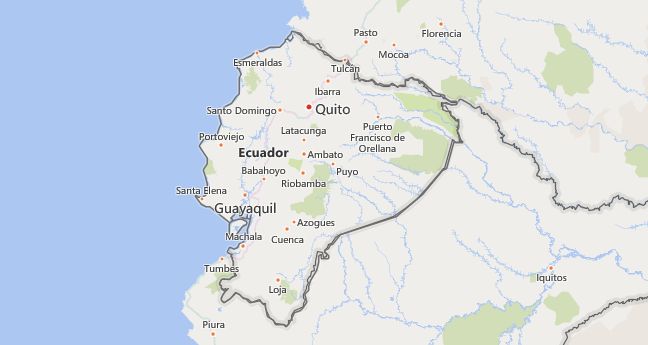There are 20 high school codes in Ecuador today, according to the ACT. The full list is shown below by city, with name of each high school and the city where the school is located (based on the ACT official site). You can search a school code by pressing “Ctrl” + “F” and then type school name or 6-digit school code.
Map of Ecuador
High School Codes by City
- High School Code
- 930020
- High School Code
- 930021
- High School Code
- 930100
- High School Code
- 930209
- High School Code
- 930405
- High School Code
- 930200
- High School Code
- 930201
- High School Code
- 930250
- High School Code
- 930210
- High School Code
- 930202
- High School Code
- 930208
- High School Code
- 930150
- High School Code
- 930204
- High School Code
- 930207
- High School Code
- 930311
- High School Code
- 930203
- High School Code
- 930312
- High School Code
- 930151
- High School Code
- 930205
- High School Code
- 930206
The above lists CEEB codes (College Entrance Examination Board) for all accredited Ecuador high schools. Please be informed that the list of high school codes in Ecuador may change throughout the year. If you can’t find codes for the high schools of your interest, please write to us or come back at a later time. We will update our database soon after a new high school code is added to the country of Ecuador.
Country Abbreviations
ECU is the three-letter country code of Ecuador, and EC is the two-letter country code of Ecuador. The two-letter suffix is used in top-level domains on the Internet as .ec.
Law
The highest court instance under the 2008 Constitution is the Supreme Court (Corte Suprema de Justicia) with 21 judges elected for nine years. Subordinate to it are provincial courts as well as cantonal and peace judges. The Constitutional Court (Corte Constitucional) has nine judges elected for nine years. The indigenous peoples are granted separate jurisdiction for “internal” matters.
Education
The main objectives in education are comprehensive, comprehensive and uniform basic education, especially in rural areas, as well as the further integration of the indigenous population groups. There is general compulsory schooling between the ages of 6 and 15. After pre-school, there is a six-year primary school and the secondary school, which is divided into two three-year cycles. In the tertiary sector there are 55 universities and (technical) colleges under government or private sponsorship. The oldest university is the Universidad Central del Ecuador (founded in 1769) in Quito.
Media
The media landscape is shaped by private companies. However, the state is expanding its media activities. A media law from 2013 makes reporting critical of the government more difficult.
Press: The largest daily newspapers are “El Comercio” (founded 1906), “Hoy” and “La Hora” (both founded 1982) in Quito as well as “El Universo” (founded 1921) and “El Diario Extra” (founded 1974) in Guayaquil. The country’s oldest daily newspaper, El Telégrafo (founded in 1884), was bought by the state in 2007.
News agency: “Agencia de Noticias del Ecuador y Suramérica” (ANDES, founded in 2009, state-owned).
Broadcasting: Around 700 radio stations broadcast mostly local programs. In addition to the state-owned companies »Ecuador TV« (founded in 2007), TC Televisión (founded in 1968), there are several commercial television stations, including »Canal Uno«, »Ecuavisa«, »Gama TV«, »RTS«, »TC Mi Canal« and “Teleamazonas”.
Forestry: The forestry use of the large forests, especially in the Orient (forest area around 51% of the total area) is only low due to a lack of traffic. The most important is balsa wood, for which Ecuador is the main supplier in the world market. Most of the logging is used as firewood. The high proportion of illegal logging is problematic.
Fisheries: Fisheries are still one of the most important branches of the economy. For their protection, the fishing zone was extended to 200 nautical miles off the coast. There are rich fishing grounds in the Galápagos Islands and off the coast in the area of the nutrient-rich Humboldt Current. The annual catches fluctuate strongly depending on changes in the ocean current (El Niño). Shrimp are grown in aquaculture. Ecuador is one of the largest shrimp exporters in the world. The shrimp farms threaten the existence of ecologically valuable mangrove forests.
Population
The largest population group are the mixed descendants of whites and indigenous peoples (around 72%). The Montubio, a mixed coastal people, have a population of 7%. It has been recognized as a separate ethnic group since 2001. Indigenous people are represented with 7%, whites with 6% and Afro-Ecuadorians with 4%. The indigenous people of the Sierra mostly speak Quechua or Chibcha.
With (2017) 67 residents per km 2, Ecuador has one of the highest population densities in South America. However, the population is very unevenly distributed. The main settlements are the Costa and the Sierra, while only about 5% of the residents live in the Orient. Due to the strong internal migration, almost two thirds of the population now live in cities; the largest metropolitan areas are Guayaquil and Quito with their rapidly growing slums. Around two to three million Ecuadorians live as migrant workers abroad.
The biggest cities in Ecuador
| Biggest Cities (Residents 2010) | |
| Guayaquil | 2,278,700 |
| Quito | 1 607 700 |
| Cuenca | 329 900 |
| Santo Domingo | 270 900 |
| Machala | 231 300 |

